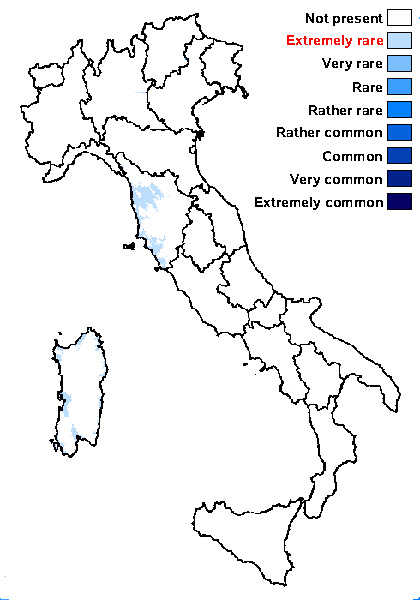Lecanora zonata Bagl.
Nuovo G. Bot. Ital., 3: 237, 1871.
Synonyms:
Distribution: C - Tosc, Sar.
Description: Thallus crustose, episubstratic, grey-brown, thinly rimose-areolate to verruculose, subeffigurate, delimited by a distinct, zoned, blue-black prothallus. Apothecia lecanorine, at first innate, then sessile and strongly constricted at base, sometimes substipitate, round to angular by mutual compression, with a dark brown, epruinose, flat to finally convex disc, and a thin, finally sometimes excluded thalline margin. Epithecium brown; hymenium colourless, I+ blue; hypothecium colourless. Asci 8-spored, clavate, very thin-walled, with a K/I+ blue, tall tholus penetrated by a faintly amyloid apical cushion, the wall K/I-, surrounded by a blue outer layer, Lecanora-type. Ascospores 1-celled, hyaline, 2-4-times as long as wide, with obtuse ends, often biguttulate, Photobiont chlorococcoid. Spot tests: unknown. Chemistry: unknown. (mostly derived from the original description)Note: an interesting, rare lichen growing on siliceous, often iron-rich rocks, which deserves further study, also reported from France (Roux & coll. 2014).
Growth form: Crustose
Substrata: rocks
Photobiont: green algae other than Trentepohlia
Reproductive strategy: mainly sexual
Species of metal-rich rocks
Poorly known taxon in need of further study
Commonnes-rarity: (info)
Alpine belt: absent
Subalpine belt: absent
Oromediterranean belt: absent
Montane belt: absent
Submediterranean belt: absent
Padanian area: absent
Humid submediterranean belt: absent
Humid mediterranean belt: extremely rare
Dry mediterranean belt: extremely rare

Predictive model
Growth form: Crustose
Substrata: rocks
Photobiont: green algae other than Trentepohlia
Reproductive strategy: mainly sexual
Species of metal-rich rocks
Poorly known taxon in need of further study
Commonnes-rarity: (info)
Alpine belt: absent
Subalpine belt: absent
Oromediterranean belt: absent
Montane belt: absent
Submediterranean belt: absent
Padanian area: absent
Humid submediterranean belt: absent
Humid mediterranean belt: extremely rare
Dry mediterranean belt: extremely rare

Predictive model
 INDEX FUNGORUM
INDEX FUNGORUM
 GBIF
GBIF

